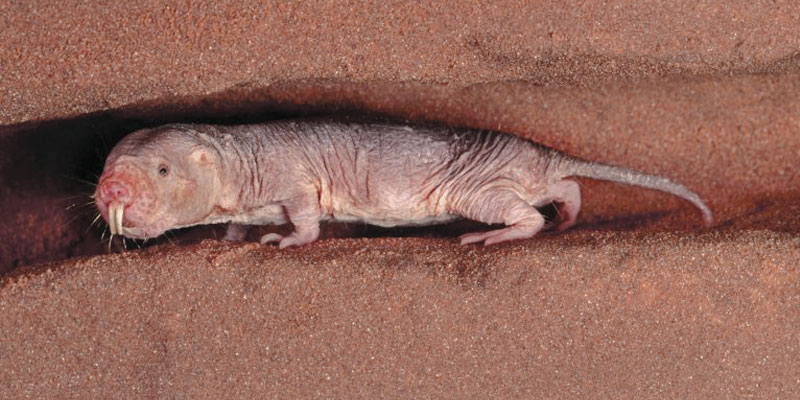The family Bathyergidae contains the blesmoles and mole rats and is within the suborder Hystricomorpha, of the order Rodentia. Evidence shows that members of this family belong to the Old World Hystricognathi lineage and are closely related to Petromuridae, Thyronomyidae, and Hystricidae. The divergence of the Old World and New World lineages occurred during the Eocene in Africa, between 55 and 34 million years ago. Bathyergids originate in sub-Saharan Africa and are small to medium sized. Bathyergidae consists of 5 genera and 16 species. The genera are Bathyergus, Cryptomys, Georychus, Heliophobius and Heterocephalus. These five genera are further separated into two subfamilies. The first subfamily, Bathyerginae, includes the genus Bathyergus and its two species. This subfamily is characterized by large front claws and a groove in their upper incisors. The second subfamily, Heterocephalinae, includes the genera Georychus, Heliophobius, Cryptomys, and Heterocephalus. This subfamily lacks the large claws and groove in their upper incisors. Species within this family include the Naked Mole Rat and the Silvery Mole Rat.
All members of the family live fossorial lifestyles and have physical characteristics to accommodate such underground living and digging, including short legs, a tapered body, small ears and eyes, and large incisors. In order to burrow, bathyergids utilize their powerful incisors to loosen dirt, which is prevented from entering the mouth by an adaptation enabling them to tightly close their lips behind their dental digging tools. The loosened dirt is moved away from their path using their feet. The hind feet are mostly broad and short-clawed, but their legs are not so extremely adapted to digging as in other tunnelling small mammals like moles, since bathyergids do not need these for digging. This is true for all members of the family apart from the genus Bathyergus, which uses its arms to burrow and therefore has very long claws. Due to the reduced nature of their eyes, bathyergids do not use sight frequently, if at all, when underground. However, unusual air movements underground may be detected by the eye surface, giving the animals warning of the opening of a normally-sealed burrow entrance. It is the sense of touch that is vital to this family. When underground, bathyergids feel for their surroundings using their short tails and long, specially adapted sensory hairs, which are the only hairs remaining on the bodies of Naked Mole Rats (Heterocephalus glaber). Bathyergids’ fusiform bodies and exceptionally loose skin allow them to reverse directions easily within the narrow confines of their burrows, at which times the tail is used as a tactile organ. Members also have hypsodont dentition, which reflects their primarily herbivorous diet. Compared to other rodents, bathyergids have a long lifespan, often between 12 and 26 years. Most are solitary, but the genera Heterocephalus and Cryptomys are unique due to their more complex social systems.
The African Mole Rat, Cryptomys hottentotus, lives in subterranean social colonies of around five animals. The generation time within colonies is about three years, in which time a single reproductive pair produce litters of two to six pups. In preferred habitats, more than 150 animals may be found per square kilometre.
Naked Mole Rats, H. glaber, live in eusocial colonies of on average 75 to 80 animals, although up to 290 have been found in a single colony. These are extended family groups, in which multiple adult generations overlap and most animals do not breed. One dominant female mates with up to three breeding males, producing litters of between one and 28 pups. Litters can be borne every 76 to 84 days, so wild females frequently give birth to more than 50 offspring per year, delivered in four to five litters (Jarvis & Sherman 2002). The dominant female’s aggressive behaviour sociologically supresses any reproductive behaviours in the rest of the colony, which instead help to care for the breeding adults and offspring: gathering food, maintaining the tunnels, and defending the colony burrow system. Individual non-breeders specialise in different tasks. Such cooperative brood care and the division of labour into reproductive and non-reproductive castes is often seen in colonial invertebrate species but is rare among mammals. The naked mole rat is one of the most highly social mammal species in existence.






